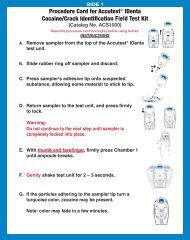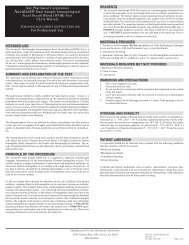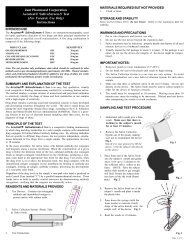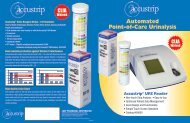MultiDrug Screen Card One-Step Panel Test - Accutest
MultiDrug Screen Card One-Step Panel Test - Accutest
MultiDrug Screen Card One-Step Panel Test - Accutest
- No tags were found...
Create successful ePaper yourself
Turn your PDF publications into a flip-book with our unique Google optimized e-Paper software.
<strong>MultiDrug</strong> <strong>Screen</strong> <strong>Card</strong><strong>One</strong>-<strong>Step</strong> <strong>Panel</strong> <strong>Test</strong>A visual one-step panel immunoassay for thesimultaneous, qualitative detection of multipledrugs and metabolites in human urine. Thisproduct is used to obtain a visual, qualitativeresult and is intended for professional use. Theassay should not be used without propersupervision and is not intended for over thecounter sale to lay persons.This booklet may be used for anyavailable combinations of the Drug<strong>Screen</strong> Assays listed on page 1.Simply refer to the informationspecific to the Drug <strong>Screen</strong> Assayson your Drug <strong>Screen</strong> <strong>Card</strong>.
<strong>Test</strong> Cap<strong>Test</strong> <strong>Card</strong>Absorbent TipsSampleHOW TO INTERPRET RESULTSCTNEGATIVE NEGATIVE NEGATIVE POSITIVE INVALID INVALID(-) (-) (-) (+)Negative: Two colored lines appear adjacent to each other in the result window. Thisindicates that no drug above the cut-off level has been detected. The test line intensitymay be any shade of pink and may be weaker or stronger than that of the control line.All tests are independent of each other, it is not recommended to compare results orcolor intensity of the test lines.Positive: Only one colored line appears in the control region (C). No test line appearsin the test region (T). A positive result should not be considered conclusive and shouldbe confirmed with a more specific alternative chemical method such as GC/MS.Invalid: If no control line appears in the result window, the test should be consideredvoid. Improper testing procedures, sample tampering or deterioration of reagentsprobably occurred.For Urine ID assay see interpretation of “Urine ID Assay” results on page 8.
INTENDED USEThe <strong>Accutest</strong>® <strong>MultiDrug</strong> <strong>Screen</strong> <strong>Card</strong> is a lateral flow, one-step panel immunoassayfor the qualitative detection of multiple drugs and drug metabolites in human urine atthe following cut-off concentrations.Drug <strong>Screen</strong> Assays:Cut-OffAMP Amphetamine 1000 ng/mlBARB Barbiturates 300 ng/mlBNZO Benzodiazepines 300 ng/mlCOC Benzoylecgonine 300 ng/mlM-AMP Methamphetamine 1000 ng/mlMTDN Methadone 300 ng/mlMOR Morphine 2000 ng/mlPCP Phencyclidine 25 ng/mlTHC 11-nor-△9-THC-9-COOH 50 ng/mlThe Drug <strong>Screen</strong> assays provide only preliminary analytical test results. A morespecific alternative analytical method such as high pressure liquidchromatography (HPLC) or gas chromatography/mass spectrometry (GC/MS)must be used in order to obtain a confirmed analytical result. Clinical considerationand professional judgement should be applied to any drugs of abuse test results,particularly when preliminary positive results are indicated.Also AvailableURINE IDENTIFICATION (U-ID) ASSAY:Cut-OffU-ID Human immunoglobulin 0.5 µg/mlThe Urine ID assay provides only a visual test tool to aid in the detection ofurine substitution, gross dilution and adulteration for drugs of abuse tests. A morespecific alternative method must be used in order to obtain a confirmedanalytical result. Clinical consideration and professional judgment should beapplied particularly when urine adulteration is suspected. For determination ofurine status only. Not for medical use.1
half-lives vary from 2 – 40 hours. Detection in the urine range from 1 day for shortacting barbiturates (i.e. secobarbital) to over 1 week for long acting barbiturates (i.e.phenobarbital). Phenobarbital is a long acting barbiturate derivative that has been usedas a daytime sedative and very extensively as an anticonvulsant. Pentobarbital andsecobarbital are two examples of short acting barbiturate sedatives. Abuse ofbarbiturates can lead not only to impaired motor coordination and mental disorder, butalso to respiratory collapse, coma and even death. Barbiturates are taken orally,rectally, or by intravenous and intramuscular injections. Short-acting barbiturates aregenerally excreted in the urine as metabolites, while long-acting barbiturates willprimarily be excreted unchanged.Benzodiazepines: Benzodiazepines are the most widely used anxiolytic drugs. Theyare used extensively as anti-anxiety agents, hypnotics, muscle relaxants and anticonvulsants.They are taken orally or sometimes by injection and have half-livesranging from 2 – 40 hours. They can generally be detected in the urine for 1-2 daysfollowing use at therapeutic doses. Following extended use or high doses, they may bedetected for up to 6 weeks. Benzodiazepines are metabolized in the liver. Somemetabolites of benzodiazepines also exhibit pharmacological activities.Benzodizepines and metabolites are excreted in the urine. Their use can result indrowsiness and / or confusion. Benzodiazepines potentiate alcohol and other CNSdepressants. Psychological and physical dependence on benzodiazepines candevelop if high doses of the drug are given over a prolonged period.Cocaine: Cocaine derived from leaves of the coca plant, is a potent central nervoussystem stimulant and a local anesthetic. Among the psychological effects induced byusing cocaine are euphoria, confidence and a sense of increased energy,accompanied by increased heart rate, dilation of the pupils, fever, tremors andsweating. Cocaine is excreted in the urine primarily as benzoylecgonine in a shortperiod of time. Benzoylecgonine has a biological half-life of 5 – 8 hours, which is muchlonger than that of cocaine (0.5 – 1.5 hours), and can be generally detected in theurine for 24 – 60 hours after cocaine use.Methamphetamine: Methamphetamine is a potent sympathomimetic agent withtherapeutic applications. Acute higher doses lead to enhanced stimulation of thecentral nervous system and induce euphoria, alertness and a sense of increased3
energy and power. More acute responses produce anxiety, paranoia, psychoticbehavior and cardiac dysrhythmias. The pattern of psychosis which may appear athigh doses may be indistinguishable from schizophrenia. Methamphetamine has ahalf-life of about 15 hours and is excreted in urine as amphetamine and oxidized asdeaminated and hydroxylated derivatives. However, 40% of methamphetamine isexcreted unchanged. Thus the presence of the parent compound in the urineindicates methamphetamine use. Methamphetamine can generally be detected in theurine for 1 – 2 days following use.Morphine: The opiates such as heroin, morphine, and codeine are derived from theresin of the opium poppy. The principle metabolites of opiates are morphine,morphine-3-glucuroride, normorphine and codeine with a half-life of about 3 hours.Heroin is quickly metabolized to morphine. Thus, morphine and morphine glucuronidemight both be found in the urine of a person who has taken only heroin. The bodyalso changes codeine to morphine. Thus, the presence of morphine (or themetabolite, morphine glucuronide) in the urine indicates heroin, morphine and / orcodeine use. Morphine can generally be detected in urine for approximately 3 days.Opiates are present in poppy seeds in varying amounts and, while notpharmacologically active, they may give a positive result with opiate / morphinescreens.Methadone: Methadone is a synthetic analgesic drug that is used in the treatment ofnarcotic addicts. Among the psychological effects induced by using methadone areanalgesia, sedation and respiratory depression. Overdose of methadone may causecoma or even death. It is administered orally or intravenously and is metabolized inthe liver and excreted in the urine as methadone, EDDP, EMDP and methadol. Thekidneys are a major route of methadone excretion. Methadone has a biological halflifeof 15 – 60 hours. Methadone can generally be detected in urine for approximately3 days.Phencyclidine: Phencyclidine is an arylcyclohexylamine that was originally used asan anesthetic agent and a veterinary tranquilizer. Phencyclidine can producehallucinations, lethargy, disorientation , loss of coordination, trance-like ecstaticstates, a sense of euphoria and visual distortions. It has many street names, such as“angel dust” and “crystal cyclone”, etc. Phencyclidine can be administered orally, bynasal ingestion, smoking, or by intravenous injection. It is metabolized in the liver and4
excreted through the kidneys in urine in unchanged form and oxidized metaboliteswith a half-life of about 12 hours. Suction and urinary acidification in the treatment ofoverdose typically reduces its half-life from three days to one day. Phencyclidine cangenerally be detected in urine for 2 – 8 days. In chronic users, detection may be for aslong as 30 days.THC: Marijuana is a hallucinogenic agent derived from the flowering portion of thehemp plant. The active ingredients in marijuana, THC & Cannabinol can bemetabolized and excreted as 11-nor-△-9-THC-COOH with a half-life of 24 hours. It canbe detected for 1 – 5 days after use by infrequent smokers. In chronic smokers it maybe detected in the urine for over 4 weeks. Higher doses used by abusers producecentral nervous system effects, altered mood and sensory perceptions, loss ofcoordination, impaired short-term memory, anxiety, paranoia, depression, confusion,hallucinations and increased heart rate. A tolerance to the cardiac and psychotropiceffects can occur and withdrawal syndrome produces restlessness, insomnia,anorexia and nausea.NOTE: Times stated for drug detection in the urine are estimates only. Actualdetection times are influenced by many variables including drug half-life, rate of drugmetabolism, dose, frequency and duration of use, route of ingestion, concurrentmedication / drug use, weight of individual and fluid intake.PRINCIPLEEach <strong>Accutest</strong> <strong>MultiDrug</strong> <strong>Screen</strong> <strong>Card</strong> consists of one-step immunoassays in which achemically labeled drug competes with the drug possibly present in urine for limitedantibody binding sites. Each test strip contains a membrane which has been pre-coatedwith drug-protein conjugate on the test band. The colored antibody -colloidal goldconjugate pads are placed at the end of the membrane. The solution of colored-colloidalgold conjugate and urine moves upward chromatographically by capillary action acrossthe membrane. In the absence of drug in the urine, this solution then migrates to the testband region to form a visible line as the antibody complexes with the drug conjugate.Therefore, the formation of a visible colored band in the test zone occurs when the testurine is negative for the drug. When drug is present in the urine, the drug/metabolite5
antigen competes with drug-protein conjugate for the limited antibody binding sites. Whena sufficient concentration of drug is present, it will fill the limited antibody binding sites. Thiswill prevent attachment of the colored antibody -colloidal gold conjugate to the drug-proteinconjugate on the test band region. Therefore, absence of the color band on the test regionindicates a positive result.A control band that has a different antigen/antibody reaction is added to the membranestrip at the control region (C). This control line should always appear regardless of thepresence of drugs or metabolites. This means that negative urine will produce twocolored bands, and positive urine will produce only one band.URINE ID ASSAY:The Urine ID Assay is a one-step chromatographic immunoassay for the rapid qualitativedetermination of human IgG protein in urine. During testing, human IgG in urine samplesreacts with the colloidal gold particles coated with anti-human IgG. The mixture thenmoves across the membrane by capillary action to the immobilized anti-human IgG on thetest band region. When testing an untampered sample, a colored band with a specifichuman IgG -antihuman IgG antibody - colloidal gold particle complex will form on the testregion. Therefore clean untampered urine will produce two colored bands, andtampered (substituted, grossly diluted or adulterated) urine will produce only one band.STORAGEThe test kit should be stored refrigerated or at room temperature 2-30°C (36-86°F) Eachdevice should remain in its sealed pouch for the duration of the shelf-life.PRECAUTIONS• All drug screen assays are for IN VITRO use only.• For professional use only.• Urine specimens may be potentially infectious. Proper handling anddisposal methods should be established.• Avoid cross-contamination of urine samples by using a new specimencollection container for each urine sample.6
MATERIALS SUPPLIED• 12 or 25 individually wrapped test devices• <strong>One</strong> instruction bookletMATERIAL REQUIRED BUT NOT PROVIDED• Specimen collection container• TimerSPECIMEN COLLECTIONThe <strong>Accutest</strong> <strong>MultiDrug</strong> <strong>Screen</strong> <strong>Card</strong>s are formulated for use with urine specimens.Fresh urine does not require any special handling or pretreatment. Urine specimensshould be collected such that testing may be performed as soon as possible after thespecimen collection, preferably during the same day. The specimen may berefrigerated at 2-8°C for 2 days, or frozen at -20°C for a longer period of time.Specimens that have been refrigerated must be equilibrated to room temperatureprior to testing. Specimens previously frozen must be thawed, equilibrated to roomtemperature, and mixed thoroughly prior to testing.Note: Urine specimens, and all materials coming in contact with them, should behandled and disposed as if capable of transmitting infection. Avoid contact with skin bywearing gloves and proper laboratory attireTEST PROCEDUREReview “Specimen Collection” instructions. <strong>Test</strong> card, patient’s sample and/orcontrols should be brought to room temperature (20-30°C) prior to testing. Do notopen pouches until ready to perform the assay.1. Remove the test card from the protective pouch (if refrigerated, bring the device to roomtemperature before opening the pouch to avoid condensation of moisture on the membrane).2. In the spaces provided for identification on the test card, label with patient orcontrol identifications, operator and date. Remove the cap to expose the absorbent tips.7
3. Immerse the sample strips into the urine specimen until it is observed that apink color begins to migrate across each result window (approximately 30 seconds).Do not allow urine to touch the plastic device when immersing the samplestrips. Replace the cap to cover the sample strips. Then place the test card on a flatsurface.4. Read results within 3 to 8 minutes. Do not read results after 8 minutes.INTERPRETATION OF RESULTSCTNEGATIVE NEGATIVE NEGATIVE POSITIVE INVALID INVALID(-) (-) (-) (+)Negative:Two colored lines appear adjacent to each other in the result window. This indicatesthat no drug above the cut-off level has been detected. The test line intensity may beany shade of pink and may be weaker or stronger than that of the control line. All testsare independent of each other, it is not recommended to compare results or colorintensity of the test lines.Positive:Only one colored line appears in the control region (C). No test line appears in the testregion (T). The absence of a test line indicates a positive result. A positive resultshould not be considered conclusive and should be confirmed with a more specificalternative chemical method such as GC/MS.Invalid:If no control line appears in the result window, the test should be considered invalid.Under no circumstances should a positive sample be identified until the control lineforms in the results window. Improper testing procedures, sample tampering or test8
deterioration probably occurred. Re-test with a new card and if condition persists,contact Technical Assistance.URINE ID ASSAY:Untampered:Two colored lines should be observed in the viewing window. The line in the testregion (T) is the human IgG probe line; the line in the control region (C) is the controlline. The test line intensity may be weaker or stronger than that of the control line.Tampered:Only one colored line appears in the control region (C). The absence of a test lineindicates the sample has been grossly diluted, substituted or adulterated. Obtain asecond sample and retest with a new accutest® <strong>MultiDrug</strong> <strong>Screen</strong> <strong>Card</strong>.Invalid:No line appears in the control region which indicates improper testing procedures.LIMITATIONS OF PROCEDURE• The assay is designed for use with human urine only.• A positive result with any of the drug screen assays indicates only the presenceof a drug/metabolite and does not indicate or measure intoxication.• There is a possibility that technical and/or procedural errors as well as othersubstances or factors not listed may interfere with the test and causeincorrect results. See SPECIFICITY for lists of substances that willproduce positive results, or that do not interfere with the test performance.• If it is suspected that the samples have been mislabeled or tamperedwith, a new specimen should be collected and the test should berepeated.9
QUALITY CONTROLGood laboratory practice recommends the use of control materials to ensure proper kitperformance. It is recommended that Positive and Negative controls be used witheach new test lot and with each new shipment. Each laboratory should follow theirstate and local requirements. For Quality control materials, please consult yoursupplier. When testing the positive and negative controls, follow the same testprocedure as with a 7-8).PERFORMANCE CHARACTERISTICSA. AccuracyFor each individual drug screen assay, approximately 60 urine samples of specificdrugs were obtained from clinical laboratories. The concentration of drug present inthe samples was determined by either GC/MS, HPLC or commercial kits. Each samplewas then tested with a <strong>Accutest</strong> <strong>MultiDrug</strong> <strong>Screen</strong> <strong>Card</strong>. Additionally, approximatelyone hundred urine samples collected from presumed non-user volunteers were testedwith both. The results are as follows:10
DRUG CONCENTRATION No. of Samples <strong>Accutest</strong> <strong>MultiDrug</strong> <strong>Screen</strong>(ng/ml)Pos/NegAMP1000 57 55/2COC300 58 56/2M-AMP1000 63 62/1MOR2000 63 61/2THC50 64 64/0PCP25 50 50/0BNZO300 49 49/0MTDN300 46 46/0BARB300 (or > 2000*) 42 42/0* Concentration of Butalbital11
B. PrecisionThe precision of the <strong>Accutest</strong> <strong>MultiDrug</strong> <strong>Screen</strong> <strong>Card</strong> was determined by conductingthe test with spiked blind controls at four different sites. The control at a concentrationof 50% below the cut-off level will give a negative result and the control at aconcentration of 200% above the cut-off level will give a positive result.C. SpecificityThe specificity for the drug screen assays with each <strong>Accutest</strong> <strong>MultiDrug</strong> <strong>Screen</strong> <strong>Card</strong> wastested by adding various drugs, drug metabolites, and other compounds that are likely tobe present in urine, into drug-free normal human urine and recording the results.The following structurally related compounds produced positive results only with thespecified drug screen assay but not with the other assays on the card when tested atlevels greater than the concentrations listed below.CompoundConcentration (ng/ml)Amphetamined-Amphetamine 1,000I-Amphetamine 10,000(+/-)3,4-methylenedioxyamphetamine(MDA) 5,000Phentermine 1,000Tyramine 75,000BarbituratesSecobarbital 300Allobarbital 1,000Alphenal 300Amobarbital 1,000Aprobarbital 300Barbital 300Butabarbital 300Butalbital 2,000Butethal 300Pentobarbital 300Phenobarbital 12300
BenzodiazepinesOxazepam 300Alprazolam 600Bromazepam 100Chlordiazepoxide 300Clobazam 300Clonazepam 300Chlorazepate 200Delorazepam 3,000Diazepam 200Estazolam 300Flunitrazepam 300Flurazepam 150Lorazepam 500Lormetazepam 500Medazepam 2,000Nitrazepam 250Nordiazepam 150Prazepam 1,500Temazepam 150Triazolam 200CocaineBenzoylecgonine 300Cocaine 300Methamphetamine(+)-Methamphetamine 1,000D-Amphetamine 50,000Chloroquine 50,000(+/-)-Ephedrine 50,000(-)-Methamphetamine 25,000Mephentermine 50,000(+/-)3,4-methylenedioxymethamphetamine(MDMA) 2,00013
ß-Phenylethylamine 50,000Ranitidine 50,000Trimethobenzamide 10,000MethadoneMethadone 300Doxylamine 50,0002-ethylidene-1,5-dimethyl-3,3-diphenylpyrolidine 50,000Methadol 25,000MorphineMorphine 2,000Codeine 2,000Ethyl Morphine 2,000Hydrocodone 25,000Hydromorphone 25,000Morphine-3-ß-d-glucuronide 5,000PhencyclidinePhencyclidine 25Tenocyclidine 2,000THC11-nor-△9-THC-9-COOH 5011-nor-△8-THC-9-COOH 5011-hydroxy-△9-Tetrahydrocannabinol 2,500△8-Tetrahydrocannabinol 7,500△9-Tetrahydrocannabinol 10,000Cannabinol 10,000Cannabidiol 100,00014
With the exception of each drug specified above, the following compoundswere found not to cross-react with any of the drug strips included in the Drug<strong>Screen</strong> <strong>Card</strong>. Each compound was found not to cross react when tested atconcentrations up to 100 µg/ml.AcetaminophenAcetoneAlbuminAmoxapineAmpicillinAspartameAspirinAtropineBaclofenBenzafibrateBenzocaineBilirubin(+)-BrompheniramineCaffeineCarbamateCarbamazepineCarisoprodol(+)-Chlorpheniramine(+/-)-ChlorpheniramineChlorpromazineChlorprothixeneChlorthalidoneClofibrateCreatineCreatininer-CyclodextrinCyproheptadineDantroleneDexamethasoneDexbrompheniramineDextromethorphan4-DimethylaminoantipyrineDiphenhydramine5,5-DiphenylhydantoinDopamineEcgonineEcgonine Methyl Ester(-)-ψ−Ephedrine(+)-ψ−Ephedrine(+)-EpinephrineErythromycinEthanolFenofibrateFentanylFluoxetineGemfibrozilGlucoseGuaicol Glyceryl EtherHemoglobinDL-HomatropineHydrochlorothizideIbuprofen(+/-)- IsoproterenolKetamineLidocaineMaprotilineMethanolMethylphenidate2-IN-morpholinolathanesaltonic acidMethaqualone(1R,2S)-(-)-N-Methyl-EphedrineNaltrexone15
ß-Naphthalene Acetic Acid(+)-Naproxen(-)-NicotineNicotinic Acid(+/-)-NorephedrineNoscapine HydrochlorideOrphenadrineOxalic AcidPenicillin-GPentazocinePhenothiazinePhenelzineL-PhenylephrinePrimidoneProcainePromethazine2-Propypentanoic acidPseudoephedrined-PropoxypheneQuinidineQuinineRiboflavinSalicylic acidSodium ChlorideSulindacTheophyllineThioridazinecis-ThiothixeneD(+)-TrehaloseTrifluoperazineVitamin C16
BIBLIOGRAPHY OF SUGGESTED READING1. Aniline O., Pittes, F. N., Phencyclidine (PCP): A review and perspectives.CRC Crit. Rex. Toxicol, 1982, 10, 145-177.2. Baselt, R.C. Disposition of Toxic Drugs and Chemicals in Man.Biomedical Publications, Davis, CA, 1982.3. Urine <strong>Test</strong>ing for Drugs of Abuse, National Institute on DrugAbuse (NIDA), Research Monograph 73, 1986.4. Ellenhorn, M.J. and Barceloux, D.G. Medical Toxicology. Elsevier SciencePublishing Company, Inc., New York, 1988.5. Fed. Register, Department of Health and Human Services,Mandatory Guidelines for Federal Workplace Drug <strong>Test</strong>ingPrograms, 53, 69,11970-11979, 1988.6. Gilman, A. G., and Goodman, L. S. The Pharmacological Basis of Therapeutics,eds. MacMillan Publishing, New York NY, 1980.7. Gorodetzkym, C. W., Detection of Drugs of Abuse in Biological Fluids, in MartinWR(ed): Drug Addiction I, New York, Spring - Verlag, 1977.8. Greenblatt, D.J., Shader, R.I. Benzodiazepines in Clinical Practice. New York:Raven Press, 1974.9. Harvey, R.A., Champe, P.C. Lippincotts Illustrated Reviews. Pharmacology.91-95, 1992.10. Hofmann F.E., A Handbook on Drug and Alcohol Abuse: The Biomedical Aspects,New York, Oxford University Press, 1983.11. McBay, A. J. Clin. Chem. 33, 33B-40B, 1987.17













